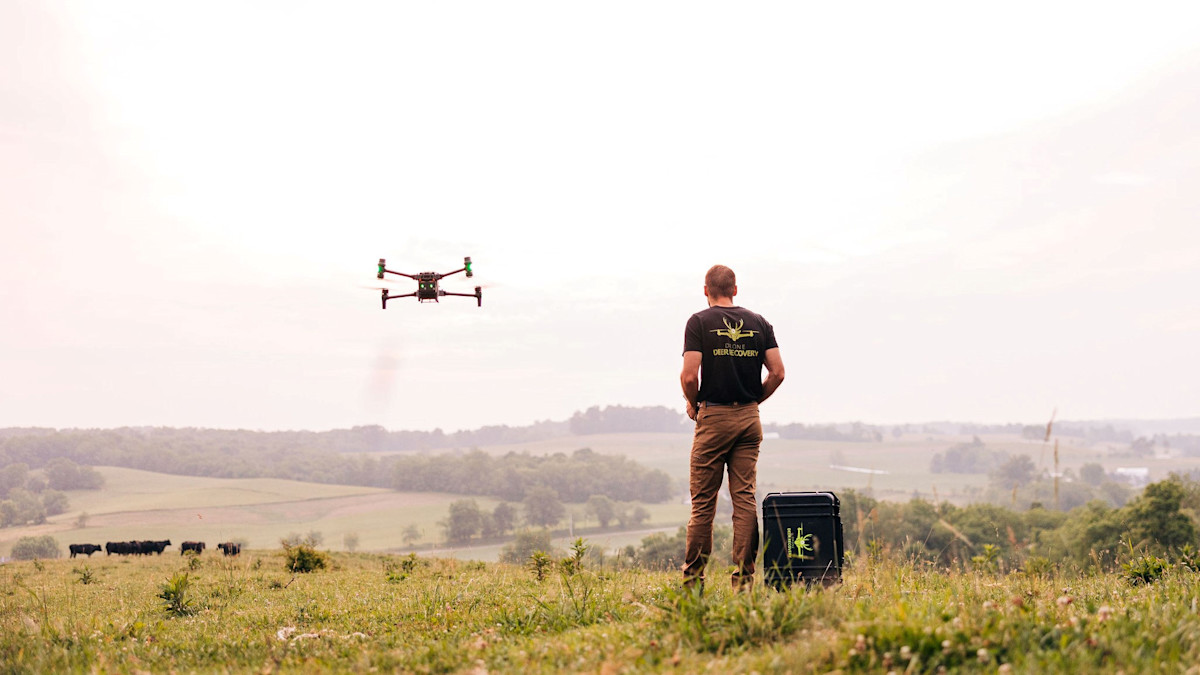
Under a light snow, an infrared-equipped drone buzzes a timbered property somewhere in the Midwest heartland. The operator, Mike Yoder, watches a screen on his controller, looking for the heat signatures of deer. As the light fades, he finally narrows in on a static target in a dense pocket of brambles and trees.
It’s a monster whitetail buck—shot the previous day by a bowhunter who lost the blood trail and was unable to recover the animal. As a last-ditch effort, the hunter called Yoder’s company, Drone Deer Recovery, to employ his infrared drones in finding the deceased deer.
The YouTube video is just one of dozens produced by the company, extolling the effectiveness of their drone services in recovering dead animals, shot and fatally wounded by bowhunters.
But recently, Yoder’s company has come under scrutiny by the Michigan Department of Natural Resources (DNR), who have deemed the business is in violation of the state law mandating that “An individual shall not take game or fish using an unmanned vehicle or unmanned device that uses aerodynamic forces to achieve flight.” In another statute, the law defines “take” to include collecting animals. Michigan isn’t alone in prohibiting the use of drones in hunting applications. Most states have a similar statute prohibiting their usage.

DNR contacted Drone Deer Recovery via email in January to inform them that using drones to locate dead deer in Michigan is illegal. According to the DNR’s interpretation of the law, using drones to find already dead animals constitutes an illegal “take” of game. Violating the statue is a misdemeanor punishable by up to a $1,000 fine and 90 days in prison.
In late July, Yoder and his pro-bono lawyers from the Pacific Legal Foundation filed an official complaint with a US district court alleging that Michigan’s interpretation of the drone statute violates both the First and Fourteenth Amendments of the US Constitution. The complaint argues that under the First Amendment, Yoder has the right to create and disseminate information related to the location of downed game.
Yoder also alleges that the law is unfairly applied differentially to private citizens and state organizations. The state of Michigan uses drones to conduct forest-health surveys and is looking into its potential for wildlife surveys, but it prohibits private citizens from using them in a similar capacity. “DNR can use the drones to do any kind of activity it chooses, but allows no one else to do the same,” Yoder told AgWeb Farm Journal. “Their position is ridiculous because drones can be used for the good of hunters, the state, and the overall deer population. I’m fighting for what’s right.”
On the flip side, however, allowing the use of drones in hunting-related applications has the potential to open a whole new can of worms, such as using the unmanned aircraft to scout and locate live animals. It’s a valid concern—in Deer Drone Recovery’s YouTube videos, it’s easy to spot live deer, bedded in tucked away spots where they would never be discovered by hunters.
"I get the concern with drones in the deer woods, but I think when it comes to recovery efforts they could be an incredible tool,” says Tony Peterson. “When it comes to doing our best to recover mortally hit deer, I don't think the usage of drones is too far. I think it's a savvy use for this technology, and while I think it should probably be regulated somehow, I don't think it should be banned outright because of the fear that someone might scout deer with a drone."
To address concerns, Yoder’s company will not fly drones for animals that may still be alive. Before Yoder will provide his services, a hunter must sign paperwork attesting that he believes the deer to be dead. If not, Yoder will wait a day or more before launching drones.
In the actual recovery process, Yoder flies $14,000 drones at over 400 feet above ground level—an elevation at which deer can’t even detect the sound. The drone’s cameras are capable of over 200X magnification, and conduct a search for thermal heat signatures, which are detectable in a carcass for several days after an animal’s death. The company touts the service as “more effective and reliable than tracking dogs and trail cameras,” a claim which their popular videos seem to corroborate. Yoder and his team recover dead deer buried in snow, brambles, and all manner of timber.
While the use of drones in recovering animals is relatively new—Yoder started Drone Deer Recovery in fall, 2022—it’s growing rapidly, and the company currently operates in 15 mostly-midwestern states. They’re venturing into a gray area that seems likely to be sorted out in court. As is, though, there are still some situations where the use of drones is unequivocally prohibited, such as in federal wilderness areas. National Forest lands out west could also prove an obstacle, because drones must be operated at under 400 feet—an elevation at which animals could likely detect or be spooked by the noise. Regardless, it’s a creative solution to carcass recovery, and one whose fate will likely be determined in short order.





